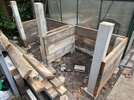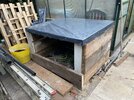I would basically agree with what
@JohnD said.
I currently have two wooden bins, each c. 1 cu. yard, and I keep on adding stuff to bin 1 until it is full then I empty it into bin 2. During the course of adding stuff to bin 1 it may well reach the top but a while later will have gone down making more room - that can happen many times before the bin is really full.
Moving from bin 1 to bin 2 is the only time that I turn mine, but then I am not in any hurry. In bin 1 the material breaks down into smaller pieces so it mixes up much better and when it goes into bin 2 it breaks down a lot more.
If the brown and green materials are quite distinct (e.g. wood chip and grass) then then layers need to be quite thin as the bacteria that do the work will only really grow on the interface between the brown and green layers. Moving from one bin to another will mix everything up.
Anything at all firm needs to be shredded, to maximise the surface area available. I have loads of ivy in my garden. When I have put a bunch of that in, upon moving the material the leaves will have fallen off but the ivy stems will be intact and seem to have been acting a bit like a spring, keeping the material apart. So I always use a pair of shears to chop up ivy, and anything like that, into shorter pieces.
I don't cover mine, even so when I have got the ratio right and the material well mixed I have got it up to 70º C and I regularly get it above 50º.
The bacteria need water and I add (at least ) one can of water whenever I add a significant amount of material. When I move it from bin 1 to bin 2 I get a mate to hold a hose putting a mist of water onto the material as it goes in.



